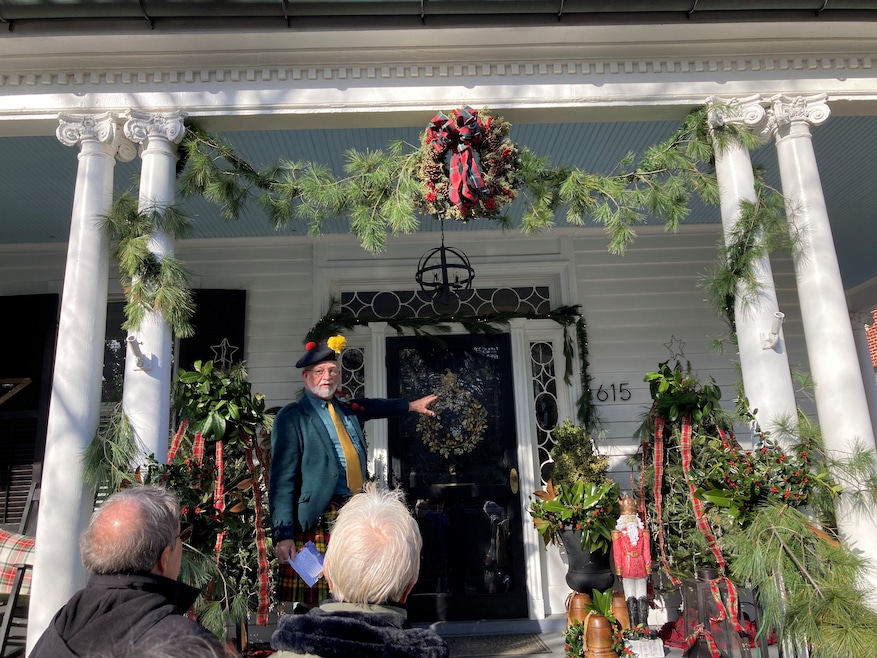On a weekend before Christmas, locals and out-of-towners formed a line outside eight houses in downtown Fredericksburg, Virginia. They braved the cold to have a peek inside these historical homes, whose owners were eager to show off seasonal decorations, furniture and artworks, and distinctive architecture.
Mike Casey, a Fredericksburg resident who was touring the houses with his wife Hillary and her mother Dale Ball, was among those eager to see the insides of a few of their neighbors’ properties.
“I like seeing the work of local artists and artisans in people’s homes and the ways different families have used the homes over the years,” he said.
Every year since 1970 during the holidays, a number of Fredericksburg residents have invited the public to their homes as part of the annual Candlelight Tour. It’s a fundraiser for the Historic Fredericksburg Foundation that was founded in the 1950s in response to a wave of demolitions of older houses and buildings in the downtown area.
This city of 29,000 people about 50 miles from Washington, D.C., has a rather strong sense of its history. Among its more famous residents were James Monroe, the fifth U.S. president, and George Washington’s mother Mary, for whom the local university is named. Washington himself grew up just across the Rappahannock River. A significant Civil War battle took place on the city’s edge in 1862; today the scene is a popular tourist destination.

So is the city’s lively downtown, parts of which feel like an outdoor historical museum bustling with 21st-century activity. It’s a short walk from the commercial center to where this year’s tour took place.
You won’t see a giant inflatable Santa Claus or the Grinch in front of any of the houses on the tour, said Kelley Winkler, director for the Historic Fredericksburg Foundation. The group works closely with participating homeowners to decorate their properties for the event.
“The historic town is so classic that most people when they decorate, want to keep that classic look,” she said. “As for the tour, we like to stick with fresh greens, wreaths and florals for many of our homes. But the style and design are up to the homeowner and the decorator.”
Some 20 volunteers are needed to staff each house on the $35 tour that stretches over one weekend. Visitors get an introduction from one volunteer before they even enter a house, then they hear more details about the home and its decorations from other guides as they move from entryway to living room to kitchen.
In its early years, Winkler said the tour was held in the evenings by candlelight to calm participating owners worried about visitors noticing dust in their homes. These days, worries about fire safety have put an end to the candles, and the tour is held only during daylight hours. But the event has stuck with its original name.
The houses on this year’s tour are from a range of eras with the two oldest dating to the late 1700s and the newest built in 1926. They include a variety of styles from Federal to Victorian to Dutch Colonial. Some of the houses were built for notable purposes, such as two that for a time housed widows of Presbyterian ministers and their children. Others haven’t always been houses; one contained a music school and later was a museum of historic artifacts.

The oldest property on the tour is now the Ironclad Inn, owned by a local distillery, and hasn’t been a residence since 1932. Built in 1789 with an early 20th-century extension, it was slated to be torn down in 1973 and replaced with an office building. The property was saved after a public outcry, according to the inn’s website.
Though the properties on the tour, or at least their front facades, look much as they would have when they were built, over time various owners have made changes to materials or architectural details. A volunteer at one house emphasized that the transom above the front door was original, while much of what surrounded it has been updated.
“This house is such a mishmash of different styles,” said Gayle Brown, a volunteer at another home. “It’s the same with all of us who have old houses. You’re constantly changing it and adding on to it.”

From the Homes.com blog: Your guide to buying a historic home
The process of identifying homes to include on the tour begins early in the year when the foundation looks for interested owners.
“We set up meetings with the homeowners, we get to know them, get to know their style and their house,” Winkler explained. “This helps later when we match them with a decorator.”

The decorators, who volunteer their time, typically include local florists and event designers with the foundation paying for the materials. But in at least two cases this year, the homeowners did their own decorating. D.D. Lecky, the co-owner of one house on the tour and a potter by trade, knitted numerous colorful stars to adorn two Christmas trees in her Charles Street home.
In another home, the family’s handmade Christmas stockings hung from the fireplace. A volunteer explained that the stockings were assembled from the owner’s mother’s wedding dress. In the kitchen, the family’s handwritten recipe for gingerbread was propped up for viewing on the stovetop.

Leslie Pugh, a 15-year Candlelight Tour committee member who also serves on the foundation’s board, greeted people waiting to enter one of the houses on this year's tour.
“I love Fredericksburg and that so many historical houses are still here. It’s just a fascinating place,” she said.
